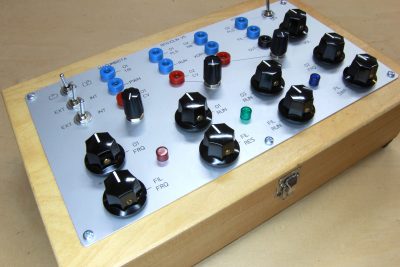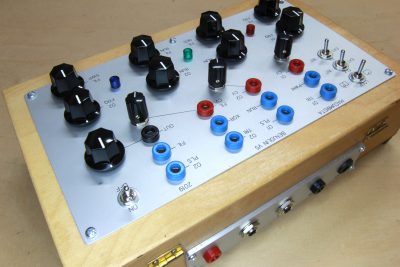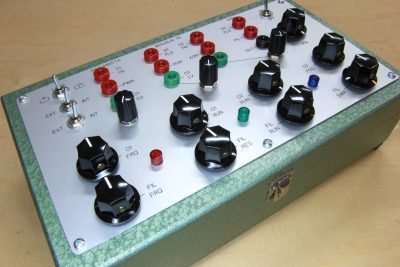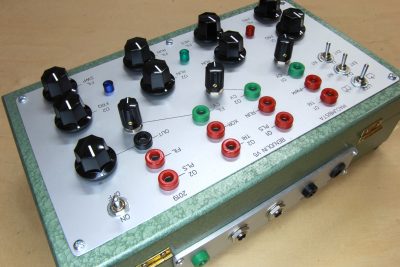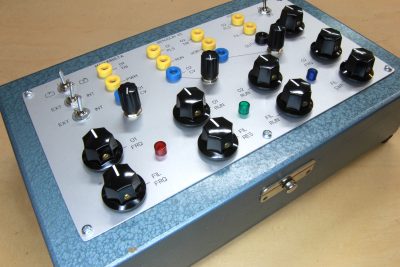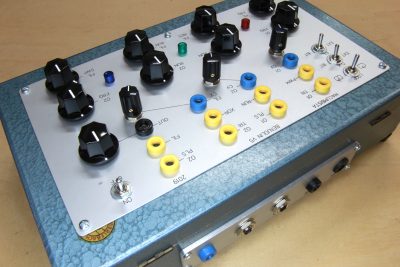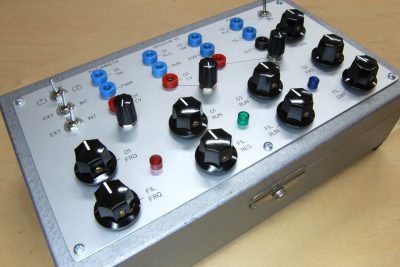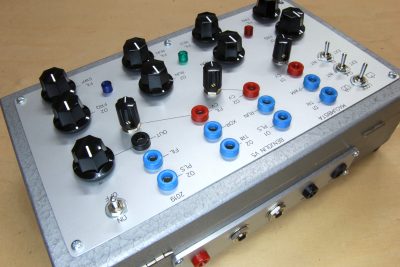Macumbista Benjolin V5
The Benjolin is a standalone synthesizer designed by Rob Hordijk from the Netherlands. It contains two oscillators (one LFO and one VCO), a voltage controlled filter and a circuit called a “Rungler”, which allows chaotic cross-modulation possibilities between the different parts of the circuit. Hordijk refers to the Benjolin as a circuit which has been “bent by design.”
These hand-made Macumbista Benjolins are officially licensed by Hordijk, and have been further customized with a patchbay, which can be used to interface with other modular synthesizers or to setup further control voltage feedback systems within the Benjolin itself, attenuators on the three control voltage input and LEDs displaying the internal state of the Rungler.
The latest Macumbista Benjolin V5 instrument has been redesigned during the spring of 2019 in collaboration with Pete Hartman of Frog Leg Synthesis. The filter input has been improved, and the main output of the instrument buffered for lower noise and ease of use with a wider range of mixers and DI boxes.
The wooden enclosures used to create these handmade analog synthesizers all date from the 1960’s and 1970’s. There are individual variations in the exact color, the size, and the marks which history have left upon them. A number of different colors are possible (subject to availability). These include a natural finish as well as three different types of “hammered metal” paint finishes in grey, green, blue, and (infrequently) red or purple. Please see the photos at the bottom of this page for examples.
A basic user’s manual can be found here.
PRICE
THIS INSTRUMENT HAS BEEN DISCONTINUED IN FAVOR OF THE NEW RM (RING MOD) SERIES.
All my instruments are made-to-order. Every Benjolin ships with one banana patch cable and a universal 110/220V AC to 12V DC power supply. Contact for availability:
MACUMBISTA at-the-domain GMAIL dot COM.
MODIFICATIONS
The Benjolin V5 contains the following modifications from Hordijk’s original Benjolin circuit:
BUFFERED OUTPUT: to get a signal to the 6.3mm (1/4″) output jack on the back on the instrument, one of the output signal banana jacks must be patched to the black OUTPUT banana jack. Typically this if the FIL output, but other output signals can be used if you are careful with the Volume levels. This signal is attenuated by the VOL knob and buffered before sending to the 6.3mm output. (Some previous versions of my Benjolins did not have this output buffered.)
LOOP SWITCH: The LOOP switch locks the otherwise chaotic pattern of the Rungler into a loop. The LEFT position is a loop of 4 steps going forward, the MIDDLE position is the normal chaos of the Rungler, and the RIGHT position is a loop of 4 steps forwards and 4 steps backwards.
EXTERNAL INPUT SWITCH: The external input 6.3mm jack on the back of this Benjolin allows a signal from another source to be sent through the Low Pass Filter of the instrument. Selecting EXT on the FIL INPUT switch sends this signal to the FIL input, where the cutoff and resonance controls of the filter can be used to affect it. When the FIL INPUT switch is in the INT position, the PWM signal, mixed with a small amount of RUN voltage, is sent to the FIL (this is the normal Benjolin signal path).
EXTERNAL RUNGLER CLOCK:: A banana jack on the back panel of the instrument provides a switchable clock source for the Rungler of the instrument. The EXT switch position clocks the Rungler from OSCILLATOR 2 of the instrument, the INT switch position clocks it from the external clock input.
VIDEOS
Duelling Benjolins from macumbista on Vimeo.
Two Benjolins cross-patched to modulate each other function identically to the Dual “Butterfly” Benjolin.
PHOTOS
Please note that you can click the images on this page for hi-res details of the panel and design.
